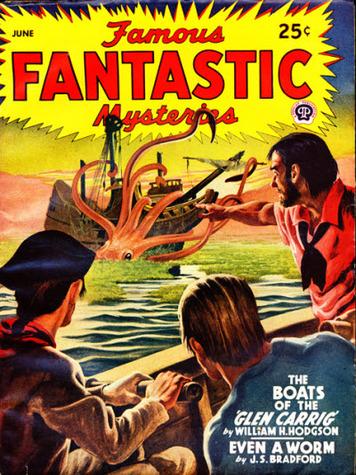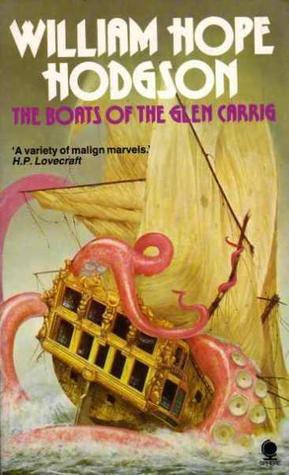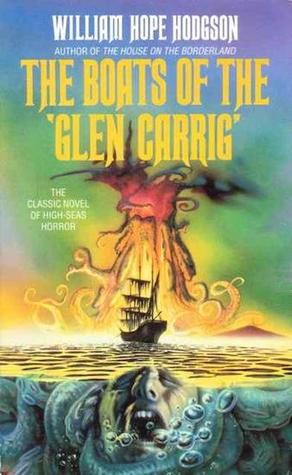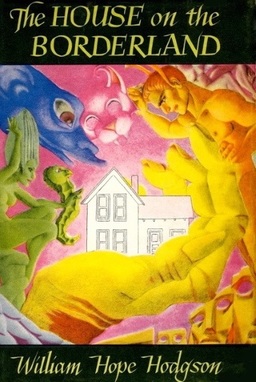Vintage Treasures: The Boats of the Glen Carrig by William Hope Hodgson
 |
 |
 |
The Boats of the Glen Carrig was first published in 1907, and it has been reprinted countless times over the last hundred years. It is currently in print in no less than five separate editions, including multiple digital formats. In virtually every sense it is a classic horror novel, by one of the great 20th Century horror writers.
It wasn’t always recognized as such. In fact, after its first appearance, it languished for decades, before it was showcased in Famous Fantastic Mysteries in June 1945, with a terrific cover by Lawrence. It was reprinted in the seminal omnibus volume The House on the Borderland and Other Novels the following year, one of the most important and collectible volumes Arkham House ever published.

That massive volume included three other novels: The House on the Borderland (1908), The Ghost Pirates (1909) and Hodgson’s most famous work, The Night Land (1912).
The Boats of the Glen Carrig remained out of print for a quarter century after that, until Lin Carter selected it as the 25th volume in the Ballantine Adult Fantasy series in February 1971.
The Boats of the Glen Carrig is written in an archaic style, even for 1907, which makes it a tough read for some modern readers, with very little dialog and some stupendously long sentences. It presents the account of the events of 1756, narrated by a passenger on the Glen Carrig, lost at sea when it hits a sunken object. The survivors escape in two lifeboats, and at this point the novel changes from a tale of nautical adventure to a horror story… as the monsters appear.
Unlike Hodgson’s famous Carnacki the Ghost Hunter stories, or his novel novel The Ghost Pirates, there’s nothing overtly supernatural in The Boats of the Glen Carrig. But the novel conjures a lost world, with unfathomable creatures from the depths of the sea, and the characters are well drawn.
The novel saw multiple editions after Carter rescued it from relative obscurity, including a Sphere paperback in 1982 (above middle, cover by Les Edwards), and a 1991 Grafton paperback (above right, artist unknown.) Night Shade did a handsome hardcover edition in July 2003, The Boats of the “Glen Carrig” and Other Nautical Adventures, part of their five-volume collected Hodgson series — which I highly recommend.
See all of our recent Vintage Treasures here.
It’s possible this is actually my favorite of Hogdson’s novels. It’s supremely creepy and atmospheric, and it’s certainly a hundred times more accessible than The Night Land.
I love ‘Glen Carrig’ as well, a top shelf weird tale.
I used to think that only Lin Carter could find something this cool that has been around for years but no one knew about it. I was wrong.
The covers are the coolest. I wish they had them in wall posters. I’m going to track down a copy and check out the sea critters promised within.
> It’s supremely creepy and atmospheric, and it’s certainly a hundred times more accessible than The Night Land.
Joe,
It’s funny – several reviewers over the years have commented that The Boats of the Glen Carrig is written in an archaic style, similar to THE NIGHT LAND. But no one talks about it being as inaccessible as that book. I wonder what the difference is?
> I love ‘Glen Carrig’ as well, a top shelf weird tale.
Thanks Bill! I’ve been enjoying your articles with Howard, over at his blog. Keep them up!
> I used to think that only Lin Carter could find something this cool that has been around for years
> but no one knew about it. I was wrong.
Ape,
To be fair, Lin Carter did find and rescue this book from relative obscurity, so maybe this isn’t the best counter-example. But I know what you mean.
> The covers are the coolest. I wish they had them in wall posters. I’m going to track down a copy and
> check out the sea critters promised within.
Aren’t they? I have trouble picking a favorite. I’m sorry I didn’t have space to include the Ballantine Adult Fantasy cover, but I figure Keith West will cover it when he gets to it!
John,
Honestly, I didn’t find Boats particularly archaic, or at least not inaccessibly so. The manuscript is supposed to date to the middle of the 18th Century, and Hogdson did a tolerable job of capturing that style; I think it helped that he had nautical experience himself, so was able to handle the terminology more naturally.
Night Land was a different beast. It wasn’t just that it was archaic — it was a very artificial style; it felt like he was trying for kind of a faux-medieval or Renaissance tone, and (sadly) just making a botch of it.
(Eddison did something similar, but much, much more successfully, in his Ouroboros and Zimiamvia books.)
After reading this post I got my copy of “Glen Carrig” out and read it for the first time ever.
Loved it!
I agree with Lovecraft’s assessment though in his Supernatural Horror in Literature: “The brooding menace in the earlier parts of the book is impossible to surpass, though a letdown in the direction of ordinary romance and adventure occurs toward the end” (p. 83, Dover edition).
The last couple of chapters seemed like something written for today’s Twilight crowd–blech!